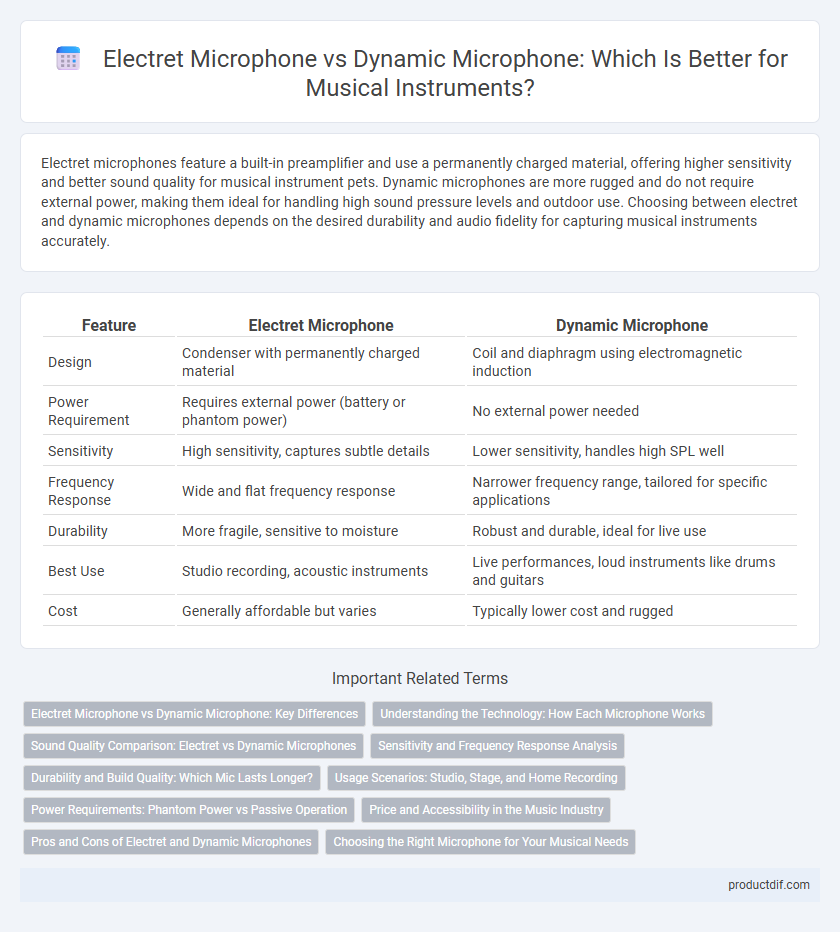Electret microphones feature a built-in preamplifier and use a permanently charged material, offering higher sensitivity and better sound quality for musical instrument pets. Dynamic microphones are more rugged and do not require external power, making them ideal for handling high sound pressure levels and outdoor use. Choosing between electret and dynamic microphones depends on the desired durability and audio fidelity for capturing musical instruments accurately.
Table of Comparison
| Feature | Electret Microphone | Dynamic Microphone |
|---|---|---|
| Design | Condenser with permanently charged material | Coil and diaphragm using electromagnetic induction |
| Power Requirement | Requires external power (battery or phantom power) | No external power needed |
| Sensitivity | High sensitivity, captures subtle details | Lower sensitivity, handles high SPL well |
| Frequency Response | Wide and flat frequency response | Narrower frequency range, tailored for specific applications |
| Durability | More fragile, sensitive to moisture | Robust and durable, ideal for live use |
| Best Use | Studio recording, acoustic instruments | Live performances, loud instruments like drums and guitars |
| Cost | Generally affordable but varies | Typically lower cost and rugged |
Electret Microphone vs Dynamic Microphone: Key Differences
Electret microphones use a permanently charged material to capture sound waves with high sensitivity and excellent frequency response, making them ideal for detailed audio capture in musical instruments. Dynamic microphones operate via electromagnetic induction, providing durability and resistance to high sound pressure levels, which suits live performances and loud instrument sources. The key differences lie in the electret's precision and low noise floor versus the dynamic's robustness and ability to handle extreme volume without distortion.
Understanding the Technology: How Each Microphone Works
Electret microphones use a permanently charged diaphragm and backplate to convert sound waves into electrical signals, employing a built-in FET amplifier to boost the weak signal. Dynamic microphones operate on electromagnetic induction, where sound waves move a coil attached to a diaphragm within a magnetic field, generating an electrical current directly. Electret mics are favored for their sensitivity and compact size, while dynamic mics excel in durability and handling high sound pressure levels.
Sound Quality Comparison: Electret vs Dynamic Microphones
Electret microphones deliver a clearer and more detailed sound, capturing high-frequency nuances ideal for studio recordings and acoustic instruments. Dynamic microphones handle high sound pressure levels without distortion, making them suitable for live performances and loud instruments like drums and electric guitars. The choice depends on the desired sound clarity versus durability and versatility in different audio environments.
Sensitivity and Frequency Response Analysis
Electret microphones exhibit high sensitivity and a wide frequency response, typically ranging from 20 Hz to 20 kHz, making them ideal for capturing detailed, nuanced sounds in musical instruments. Dynamic microphones show lower sensitivity but excel in handling high sound pressure levels without distortion, with a frequency response usually between 50 Hz and 15 kHz, favoring robust and loud sound sources like drums and guitar amplifiers. Sensitivity differences affect signal clarity, while frequency response impacts tonal accuracy, guiding the choice between electret and dynamic microphones for specific musical instrument applications.
Durability and Build Quality: Which Mic Lasts Longer?
Electret microphones typically feature delicate internal components, making them more susceptible to damage from moisture and physical shocks compared to dynamic microphones, which are built with rugged materials suited for high-impact environments. Dynamic microphones possess a simpler, coil-and-magnet design that enhances durability and longevity, especially in live performance and outdoor settings. As a result, dynamic microphones generally outlast electret microphones in terms of build quality and ability to withstand harsh conditions.
Usage Scenarios: Studio, Stage, and Home Recording
Electret microphones excel in home recording setups due to their compact size and sensitivity, capturing detailed sound with minimal background noise. Dynamic microphones are preferred on stage and in studio environments for their durability and ability to handle high sound pressure levels without distortion. Choosing between electret and dynamic microphones depends on the recording context, balancing clarity for studio use and robustness for live performances.
Power Requirements: Phantom Power vs Passive Operation
Electret microphones require a small external power source, typically a built-in or phantom power supply, to maintain their internal capacitor charge for proper operation, making them ideal for low-noise applications. Dynamic microphones operate passively without the need for phantom power, relying solely on electromagnetic induction, which enhances durability and simplicity for stage performances. Understanding the power requirements helps musicians and audio engineers choose the right microphone type based on their equipment setup and usage environment.
Price and Accessibility in the Music Industry
Electret microphones generally offer more affordable pricing, making them highly accessible for entry-level musicians and small studios. Dynamic microphones, although often pricier, provide durability and reliability favored by live performers and professional setups. The widespread availability of electret models online contributes to their popularity, while dynamic mics require specialized retailers or trusted brands for quality assurance.
Pros and Cons of Electret and Dynamic Microphones
Electret microphones offer high sensitivity and excellent frequency response, making them ideal for capturing subtle nuances in musical instruments, but they require a power source, which can limit their portability. Dynamic microphones are rugged and handle high sound pressure levels well, perfect for live instrument performances, though they tend to have lower sensitivity and a narrower frequency range compared to electret types. Choosing between electret and dynamic microphones depends on balancing sensitivity and power requirements against durability and sound pressure handling.
Choosing the Right Microphone for Your Musical Needs
Electret microphones offer high sensitivity and clarity, making them ideal for capturing subtle acoustic instruments and vocals with detailed nuance. Dynamic microphones are durable and capable of handling high sound pressure levels, perfect for live performances and amplified instruments like drums and electric guitars. Selecting the right microphone depends on your environment, instrument type, and whether you prioritize sound fidelity or ruggedness.
Electret microphone vs Dynamic microphone Infographic

 productdif.com
productdif.com